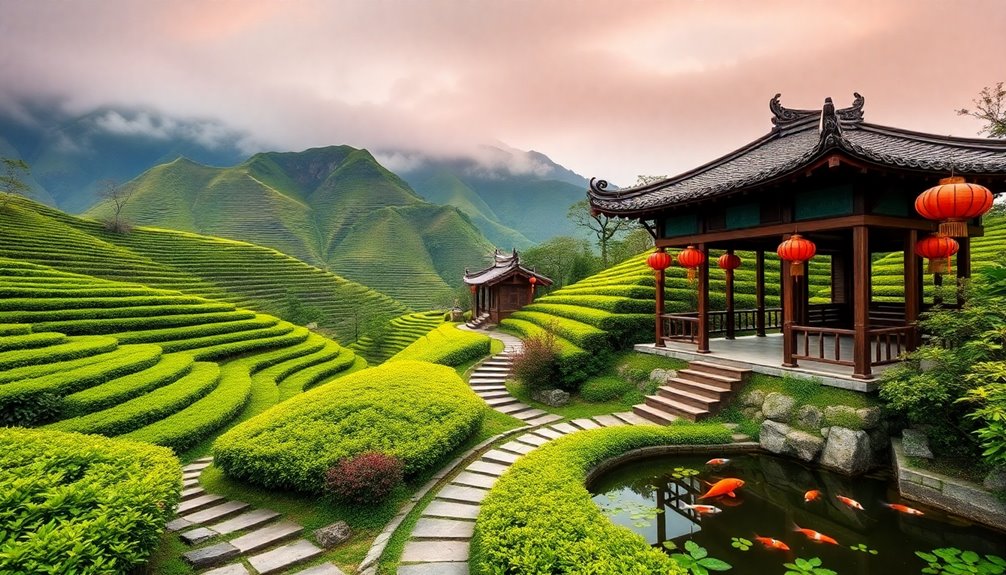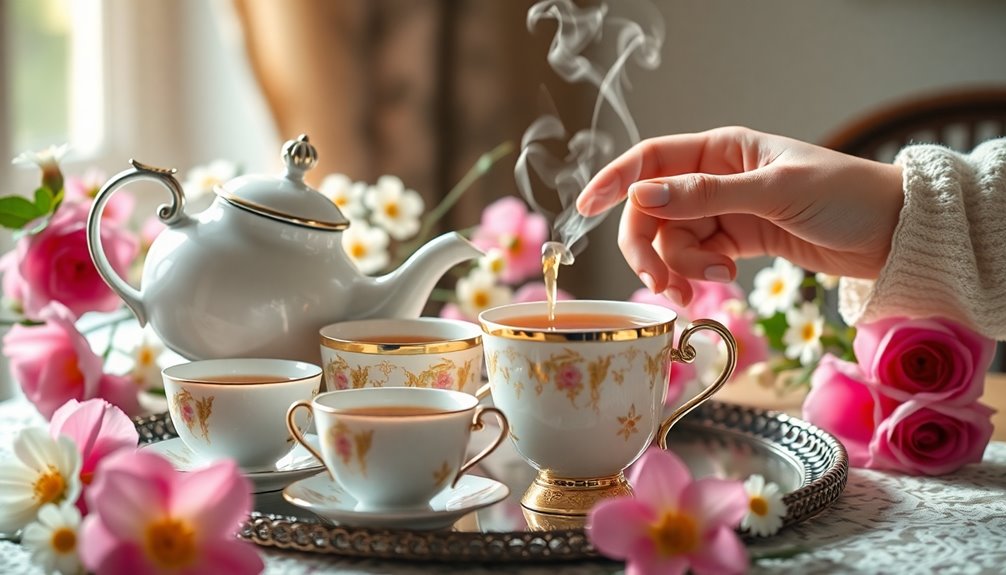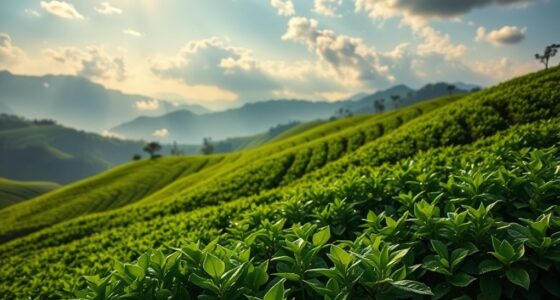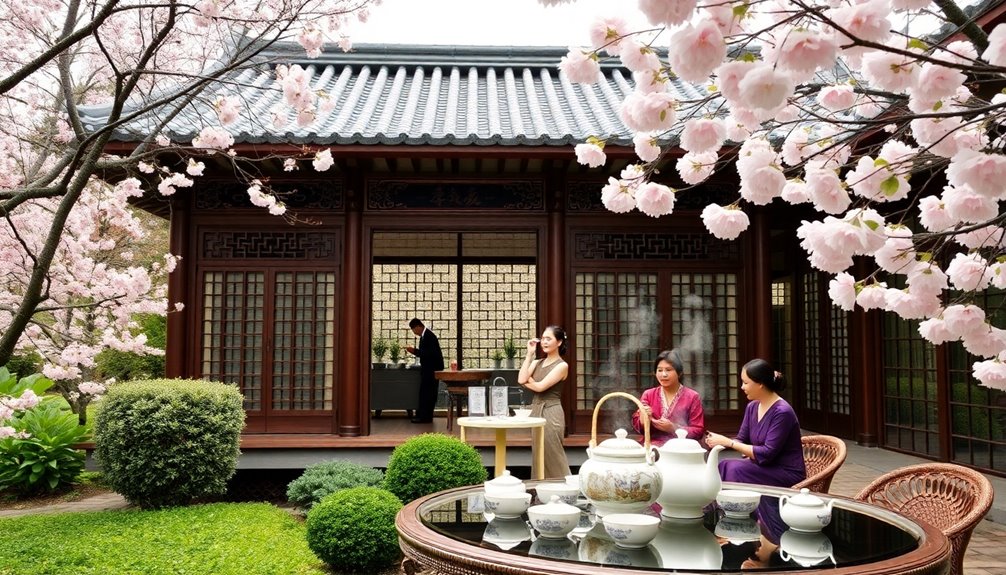You can visit ancient Chinese tea gardens, like the UNESCO World Heritage Site at Jingmai Mountain, where some tea trees are over 1,400 years old. Exploring the lush landscapes of Yunnan, Fujian, and Zhejiang, you'll connect with the rich cultural heritage of tea cultivation that dates back more than 2,000 years. Many gardens offer educational tours led by local farmers, showcasing sustainable practices and unique tea varieties. You'll enjoy scenic views and may even witness traditional performances. Discovering these gardens provides a deeper appreciation for tea's role in Chinese culture, and there's plenty more to uncover about this enchanting experience.
Key Takeaways
- Visit Jingmai Mountain in Yunnan, a UNESCO World Heritage Site, home to over 1.13 million ancient tea trees over 1,400 years old.
- Explore traditional tea gardens in Fujian, known for their oolong tea and rich cultural heritage, showcasing ancient cultivation practices.
- Experience the scenic tea terraces of Zhejiang, where you can learn about local tea varieties and sustainable farming from ethnic groups.
- Engage in educational tours with local farmers and artisans, offering insights into ancient tea processing techniques recognized as Intangible Cultural Heritage.
- Enjoy tea tasting sessions that highlight the distinct flavors and health benefits of various tea types cultivated in these ancient gardens.
Introduction

When you think of Chinese tea, images of lush green landscapes and ancient traditions often come to mind. These enchanting tea gardens, situated in regions like Yunnan, Fujian, and Zhejiang, are the heart of traditional Chinese tea cultivation. By planning a visit to these sites, you'll immerse yourself in the local culture and witness the remarkable history behind tea production.
At places such as the Jingmai Mountain tea plantations—a UNESCO World Heritage Site—you can find ancient tea trees over 1,400 years old. These gardens not only showcase unique tea varieties but also offer scenic landscapes that will leave you in awe.
Engage with local farmers and artisans as they share their knowledge about tea cultivation and processing techniques during educational tours. Additionally, participating in tea tastings allows you to savor the rich flavors of the region while appreciating the harmony between culture and nature.
Experiences like these create a deeper understanding of traditional Chinese tea practices and reveal the beauty of tea gardens that have thrived for centuries. So, pack your bags and get ready to explore the captivating world of Chinese tea!
Historic Tea Cultivation Practices

Chinese tea gardens aren't just beautiful landscapes; they represent a rich history of cultivation practices that have evolved over centuries. At places like Jingmai Mountain, recognized as a UNESCO World Heritage Site, you'll discover ancient tea plantations that highlight traditional cultivation methods adapted to extreme natural conditions.
These gardens boast approximately 1.13 million ancient tea trees, some over 1,400 years old, reflecting deep-rooted tea culture and historical significance.
You'll notice the emphasis on biodiversity, as various cultivars grow together, enhancing ecological balance and the quality of the tea produced. Local communities, including the Dai and Bulang peoples, embrace sustainable agricultural practices that honor their relationships with the environment.
They employ time-tested processing techniques, ensuring the rich flavors and qualities of the tea are preserved.
Additionally, community agreements and regulations are in place to protect these ancient tea gardens, allowing traditional techniques of planting and processing to thrive.
Cultural Significance of Tea Gardens
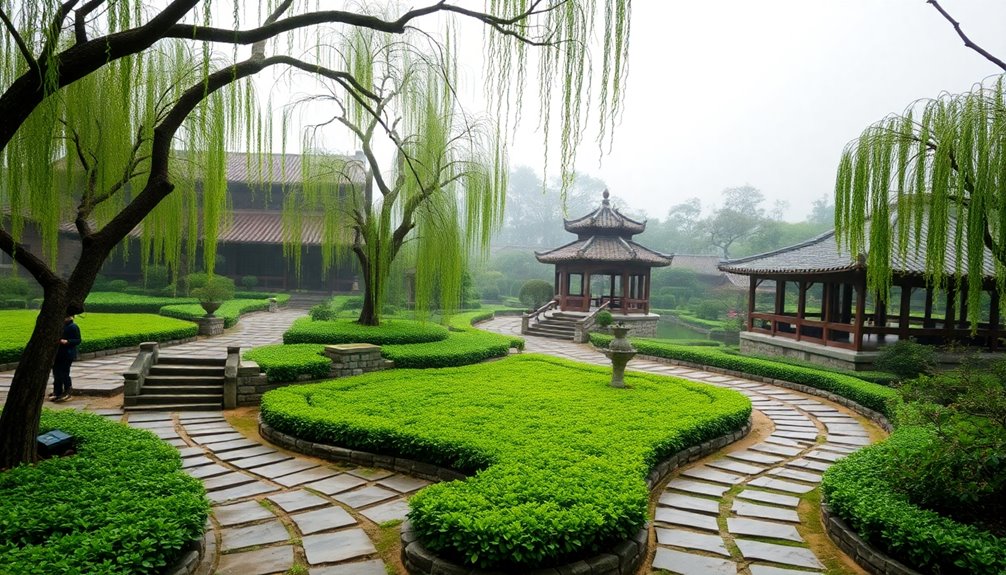
Tea gardens in China serve as vibrant symbols of cultural heritage, intertwining local traditions with the art of cultivation. These ancient landscapes, particularly those in Jingmai Mountain, reflect a harmonious relationship between tea and local culture, showcasing elements of Buddhism, Confucianism, and Taoism. Recognized as the first cultural tea landscape World Heritage Site, these gardens highlight their global agricultural significance.
The traditional tea processing techniques from these ancient gardens were added to the Intangible Cultural Heritage List in 2022, underscoring the deep-rooted practices associated with tea cultivation. These gardens play a vital role in local economies, empowering communities through cooperative models that promote sustainable agricultural practices.
Diverse ethnic groups, such as the Dai and Hani peoples, actively maintain the cultural significance of these tea gardens by preserving traditional cultivation methods and nurturing a profound connection with nature.
Visiting these tea gardens not only immerses you in breathtaking landscapes but also allows you to appreciate the intricate weave of culture, sustainability, and heritage that defines China's tea cultivation. In doing so, you become part of a rich narrative that honors both the past and the future of tea.
Ancient Tea Tree Varieties
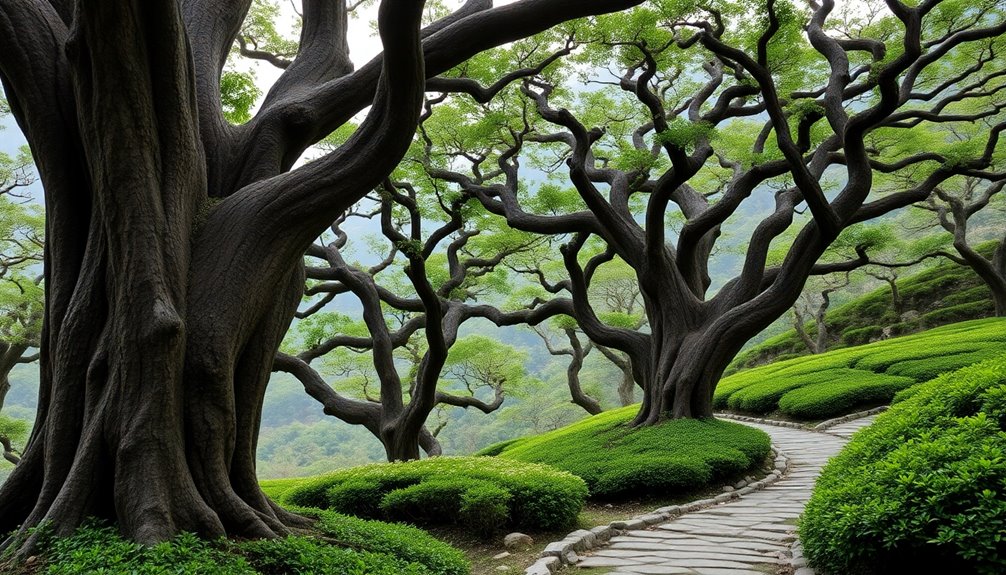
There's something remarkable about the ancient tea tree varieties found in the gardens of Jingmai Mountain. With around 1.13 million ancient tea trees, some over 1,400 years old, this region showcases the rich history of tea cultivation. The average age of these trees is about 200 years, reflecting the traditional practices handed down through generations.
You'll discover that local ethnic groups, like the Dai and Bulang peoples, cultivate diverse tea varieties using sustainable agriculture methods. Their approach exemplifies ecological wisdom, adapting to the challenging natural conditions of the area.
The unique terroir of Jingmai Mountain, nestled at elevations between 1,100 to 1,662 meters, contributes to the distinct flavors and qualities of the teas produced here.
As you explore these ancient tea gardens, you'll gain a deeper appreciation for the intricate balance between nature and human efforts in tea cultivation. These ancient tea trees not only symbolize longevity and resilience but also embody the sustainable practices that preserve the environment and cultural heritage of the region.
Visiting Jingmai Mountain offers a unique opportunity to connect with both the past and the future of tea.
Environmental Impact of Tourism
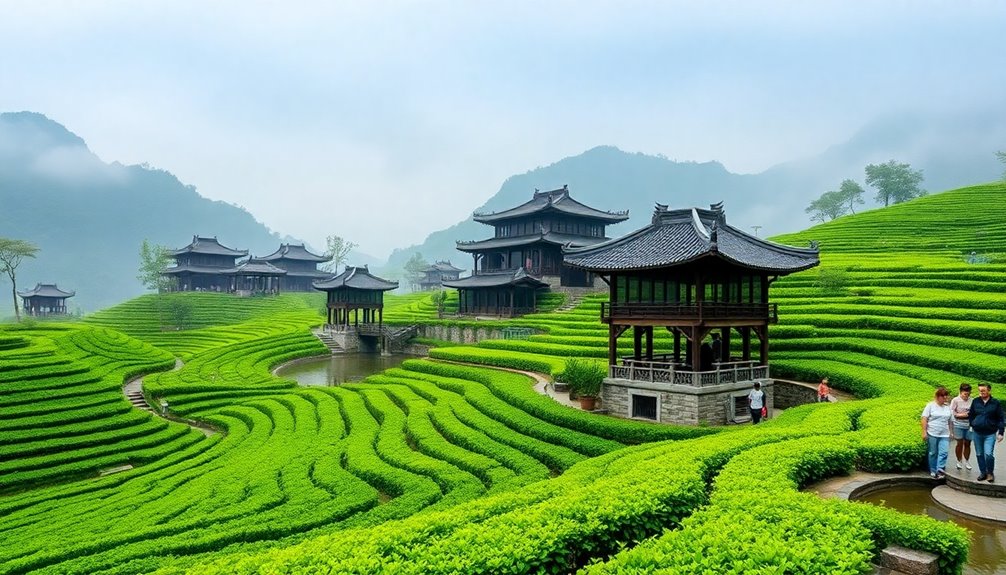
As tourism continues to grow, it brings both opportunities and challenges for ancient tea gardens. On one hand, increased visitor access can support local economies by providing jobs and income for communities dependent on tea cultivation.
On the other hand, if not managed properly, the rise in tourists can lead to soil erosion and habitat degradation, threatening the delicate ecosystems surrounding these gardens.
To mitigate these issues, sustainable tourism practices are vital. Implementing controlled visitor access and eco-friendly initiatives can significantly reduce the environmental footprint of tourism.
Additionally, the traditional methods used in tea cultivation promote biodiversity and soil health. By emphasizing these practices, tourism can bolster conservation efforts that restore and protect ancient tea gardens.
Moreover, the revenue generated from tourism can fund essential conservation projects, ensuring the preservation of these historical sites for future generations. This approach not only promotes ecological balance but also highlights the importance of protecting the environment while enjoying its beauty. Furthermore, understanding filial responsibility laws can help ensure that the financial benefits of tourism are reinvested into the local community and conservation efforts.
Practical Applications
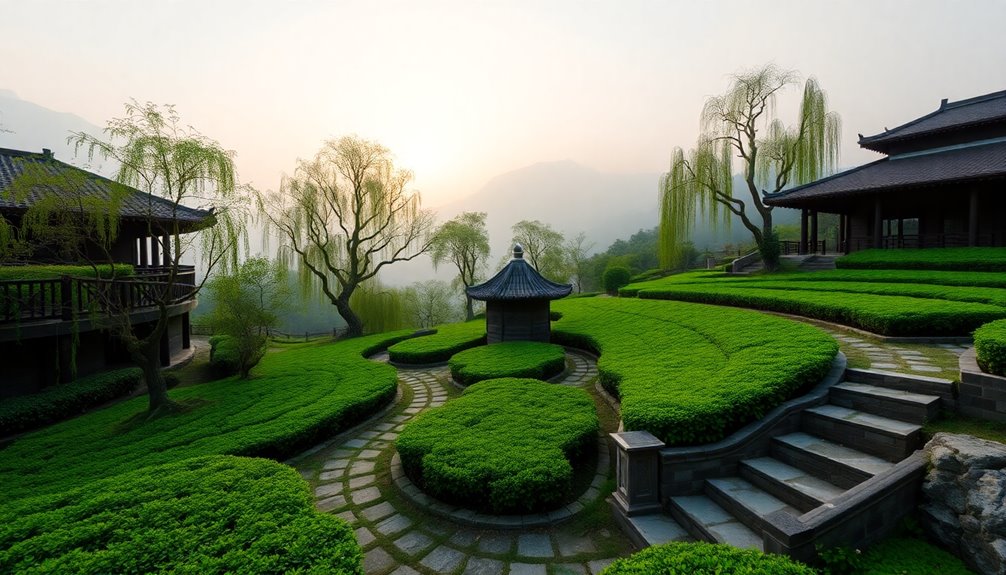
Exploring the practical applications of visiting ancient tea gardens can enrich your understanding of sustainable practices and cultural heritage. The ancient tea plantations of Jingmai Mountain, a UNESCO World Heritage Site, showcase sustainable agricultural methods, with over 1.13 million ancient tea trees, some over 1,400 years old. When you visit, you'll witness firsthand the benefits of preserving these ecosystems.
In Yixing City, you can immerse yourself in the world of Chinese tea. Participate in educational experiences at the Longjing Tea Fields, where you'll learn about tea cultivation and processing while enjoying breathtaking landscapes.
The Wuyishan region offers a chance to explore diverse micro-environments that influence the flavors of prestigious rock teas like Da Hong Pao.
Consider a travel package that includes visits to these ancient tea gardens, where you'll interact with local ethnic groups who maintain traditional tea practices.
Additionally, the Kadoorie Farm and Botanic Garden provides insights into tea cultivation and the ecological significance of these gardens, making it an ideal family-friendly destination. Engaging with these elements allows you to appreciate the rich heritage and sustainable practices that have been passed down through generations. Furthermore, embracing an abundance mindset during your visits can deepen your appreciation for the rich cultural traditions and the natural beauty surrounding these tea gardens.
Conclusion
Visiting ancient Chinese tea gardens offers you a unique glimpse into the rich history and culture surrounding tea. You'll not only experience the beauty of these landscapes but also appreciate the traditional practices that have shaped them for centuries. As you explore, you'll understand the environmental significance of these gardens and how tourism can play a role in their preservation. So, grab a cup of tea and immerse yourself in this captivating journey through time!

